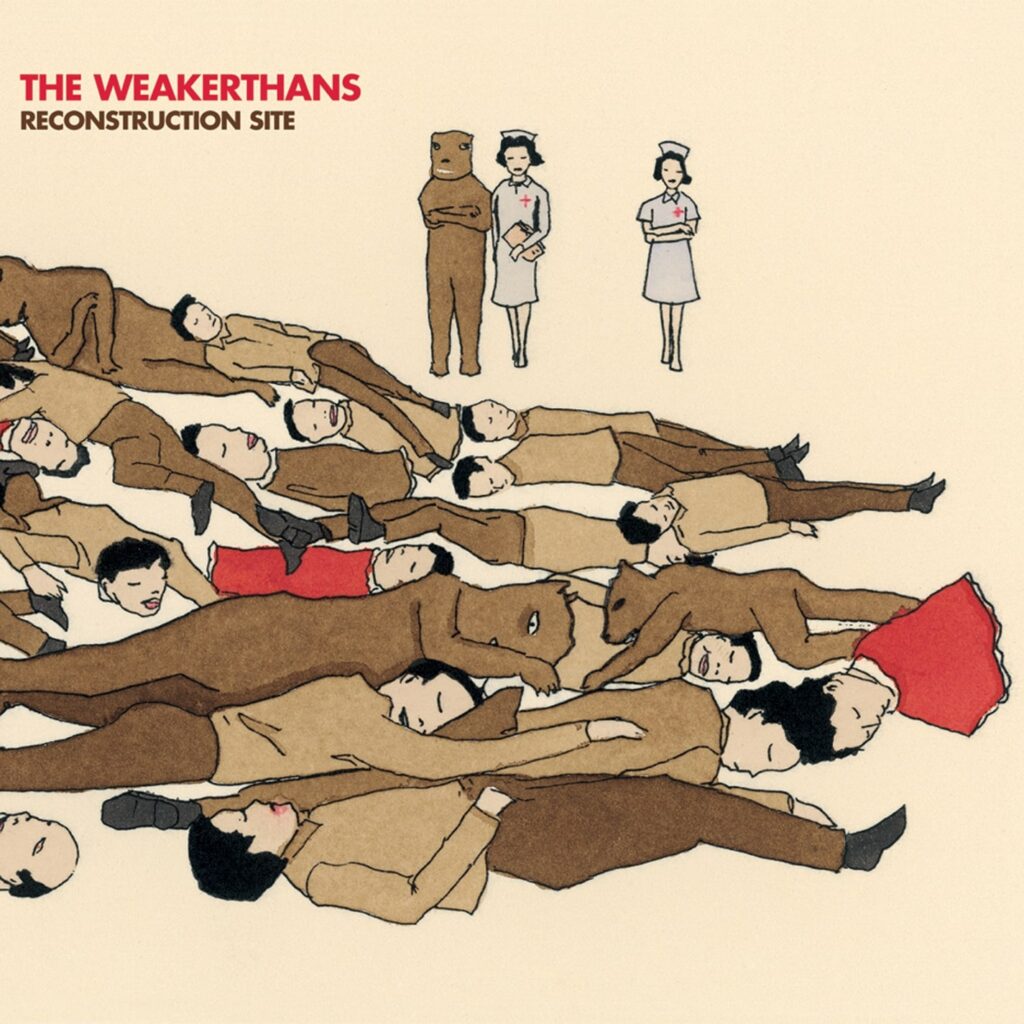
I have been trying to write this article for four months. I have never struggled so much or had so much fear about putting fingers to keys, never had an empty Google Doc stare back at me in such accusatory fashion.
I have a tattoo on my right thigh of a car with a boat tied to the roof, a reference to the title track from the Weakerthans’ Reconstruction Site. The song doesn’t mention what kind of car, so I used a reference picture of my old car, the one I sold to my teenage brother that he promptly crashed into a semi and sold for scrap. It’s the kind of story John K. Samson would tell. He’s been in my position before, too, followed around by words that he can’t quite get out. On his 2012 solo album, he sings to them: “Emaciated ghosts/ Hiding in those curtains’ creases/ I’ll let you haunt the world/ When I write my master’s thesis.”
There are many, many articles about John K. Samson and his associated projects that begin weepily, with some variation of “John K. Samson has always been there for me.” I was complaining to the very good writer and zine-maker Miranda Reinert that I was feeling too close to the album to write well about it. “I honestly don’t think there’s a lot of great writing about the Weakerthans for this reason,” she said.
She went on to say that she tried to write about John K. for a zine and hit a similar wall: “It struck me how hard it was to write about how special it feels because I think the specialness is in the ease of the band. John K.’s writing on Reconstruction Site (and always, but particularly on that one I think) is so great because it never feels labored.”
I find this to be exceedingly true, which is surprising given how precious and bookish the trappings of his art can be. His songs are narrated by cancer patients and cats and cab drivers and hockey historians and one guy who knows in his heart that he saw the real Bigfoot. He treats his albums (especially his solo releases) almost as academic undertakings with a loose thesis and a lengthy works cited list. He wanted to write fiction; he still writes poetry.
His songs often begin as exercises, like a poet would do — little prompts and games he plays with himself to find inspiration. “When I Write My Master’s Thesis” began by cribbing the first line from each verse of Bob Dylan’s “When I Paint My Masterpiece” and building his own, smaller story of loss and searching off of that skeleton: “Oh, the streets/ Of Grand Theft Auto: San Andreas fill with smoke.”
The bio on his website currently reads:
John K. Samson is a talk-singing sober leftist vegetarian Quaker who lives in Winnipeg, Treaty One Territory, with Christine Fellows. You can find the arts, crafts and musics they make at their family store, Vivat Virtute, the Vivat Virtute bandcamp, and on instagram @ vivat_virtute.
(fyi, there are no official John K. Samson social media accounts)
Samson famously does not enjoy touring or press: the exhausting trappings of music that offer none of its life-giving glow. For a period of time, the only way to interview him was via postcard, one tiny paragraph at a time (which Jonah Bayer did in 2016; the resulting article is great). He considers himself a talk-singer at best, and a low-to-middling guitar player. It’s all just in the service of telling stories. He has said he would rather be gardening at home than playing music most days, and I believe him.
So that’s the complicated nexus of it all: the gentle, deeply compassionate writer who wanted to write fiction, who tells little stories strung together with extended metaphors, humble but literary, an approach to music that is anti-careerist but artistically ambitious.
It sounds like a lot; it sounds like it should be too much. But the quiet magic of what Samson does is that every song — every line — comes alongside you like someone gently guiding you to the right subway train, touching your shoulder reassuringly, without pushing you.
Teenage John K. Samson was driven by his mom to his first Propagandhi practice. After half a decade, he found his songwriting diverging from the punk band’s sound. See: Samson’s contribution to the seminal Less Talk, More Rock, “Anchorless,” a song that he reprised for his 1997 debut album as the Weakerthans, the band he left Propagandhi to start. The Weakerthans version is over twice as long.
The Weakerthans released four albums before announcing their hiatus in 2015. Fallow, the debut, is the worst of the bunch by a margin that makes it feel set apart from the other three, despite being a perfectly serviceable soft punk record with loud guitars and big feelings. If you like Samson’s songs, you probably have one of the lyrics from this album hung up like a banner in your heart. Mine is from “Leash”: “Maybe someday/ The lies we’ve led around/ Will crawl under our beds/ And sleep off the years.”
However, anything negative you could say about Samson’s songwriting is present on Fallow: sappy leftist sloganeering and cloying similes, some big emotional swings that his reedy voice doesn’t quite carry the heft of. It’s extremely earnest, for better and worse.
By the band’s second album, however, Samson had doubled down on the earnestness and weaponized it, making it his greatest strength. “Everything Must Go!” is a drifty list of once-beloved objects that he no longer has use for, a subdued sadness at the fade creeping in between his words. As an opener, it insists on softness and smell gestures, asking you to squint at the margins of even his grandest songs. There are many ways to leap into action — brave, strong, dumb, tragic — but there’s only one way to gather dust. He wants us to look closely at what, exactly, is gathering dust.
There are still lyrics that straddle the line between emo and English major: “I’m leaning on this broken fence/ Between past and present tense.” The difference is that on Left And Leaving, they work. Every sweeping heart-on-sleeve gesture is believable, rousing, and real, drawn from experience that feels universal no matter how fiddly and zoomed-in the images are. That song, “Aside,” made it onto the Wedding Crashers soundtrack. It didn’t catapult the band into the world of MTV Spring Break stages (sadly), but it does mean this album is many people’s introduction to the band, and it’s a really good one.
The literary bent to the lyrics is there if you look but the emotion is so aching and tangible that the album became a peculiar touchstone for musicians in punk, pop-punk, and emo bands. For almost a full year, I plugged my turntable into a little practice guitar amp and fell asleep to side B of Left And Leaving.
In his eulogy for the band following the announcement of their hiatus, Dan Ozzi says flatly, “Left And Leaving is a perfect album.” He’s right. But interestingly, he closes his essay with a paraphrased lyric from Reconstruction Site: “Let it crackle and come through with a final benediction we’ll hum along to, before we say goodnight.”
Reconstruction Site turns 20 this Saturday. I need to take this occasion to say something that will feel like A Take, like I’m saying something to get a rise, but it is something small and simple that I believe is true. I think Reconstruction Site is the best Weakerthans album.
This feels less controversial than it would have been 20 years ago. I imagine that the people who would most vehemently disagree with me are dudes in their mid-to-late 30s who have a religious conviction regarding the supremacy of Left And Leaving. But Spotify currently shows that of the 10 most popular songs according to streaming data, six are from Reconstruction Site. Maybe my once-hot take has become the mainstream opinion.
Reconstruction Site was released in 2003, the band’s third album. It is anchored by a trio of sonnets, indicated by parentheses in their titles. They all take place in the hospital. They are all little prayers of one kind or another.
The first of the three, “(Manifest),” should be mentioned more in conversations about the best album opening lines: “I want to call requests through heating vents/ And hear them answered with a whisper, ‘No.’” Before two minutes have elapsed, the song erupts into triumphant horns. No matter how bleak the scene in this hospital room will shape up to be, it will be approached chin up, chest out, wind blowing, banner waving.
Song by song, Reconstruction Site stakes out plots of loneliness, uncertainty, and loss, and digs and digs and digs until the shovel hits a root of hope growing somewhere, wild and unkillable like strawberry vines. The title track begins, “I’m lost. I’m afraid/ A frayed rope tying down a leaky boat/ To the roof of a car on the road in the dark, and it’s snowing.” By the end, the narrator has scraped together the supplies for a fantastic machine that will disassemble his despair. If he can deconstruct, he can reconstruct.
On “Uncorrected Proofs,” he worries that “the stories always end the same” and “we’re all out of bandages,” but he soldiers on, searching for a different conclusion: “Sifting through translucent shards of glass/ Looking for a filament that lit the life you want.” “Benediction” tries to find where we lost our way, but in the end realizes that the answers lie at our feet: “All our accidents went purposeful and fell/ Stripped of providence or any way to tell that our intentions were intangible and sweet/ Sick with simple math and shy discoveries/ Piled up against our impending defeat.”
There’s an anxiety that runs through Reconstruction Site, a vague dread drifting like gray clouds over Winnipeg, like a hangover that chases you all day long. There’s a sense that, no matter where it comes from, it’s becoming more clear that it isn’t going away. The ode to his hometown, “One Great City!” watches a hateful wrecking ball swing through the sky, carving up the skyline until (as he says elsewhere) the city is “still breathing, but barely, it’s true/ Through buildings gone missing like teeth.” The final song (and final sonnet) “Past-Due” closes as darkness comes too early, the narrator urging you to “Give what you can: to keep, to comfort this plain fear you can’t extinguish or dismiss.”
And it is “you.” A lot of these songs are fully formed stories, one character speaking to another — some present, some conspicuously absent — but Samson knows you’re eavesdropping. He has a story that he’s busying himself with, but he glances at you, the listener, from time to time, as if to say, “There’s probably something here that concerns you, too.”
The stories are rollicking and unhinged. A member of Ernest Shackleton’s Antarctic expedition has dinner with Michel Foucault where they discuss Derrida and a French-speaking penguin. One of the album’s most subdued songs is one of its most indelible images: an Elks Lodge at last call, the neon beer signs casting their sickly glow on the secret handshake of their sacred order.
Reconstruction Site is full of supplications, benedictions, and psalms, but none have the emotional impact of the album’s centerpiece, “Plea From A Cat Named Virtute.” There are three songs about Virtute (naturally), but those are on other albums, not resolving until 2016’s “Virtute At Rest,” and there is too much to say about the first entry to worry about them right now.
Virtute the cat is worried about her owner — justifiably, it seems. He doesn’t want to play with Virtute, he drinks more than he eats, and he sleeps more than either of those two.
Virtute’s advice is remarkably practical. It seems at first less like a solution than a distraction. We should throw a party, Virtute says, and invite everyone we know (other cats, mostly, but Virtute can be forgiven for having a limited social circle, due to being a house pet and all) — no dogs allowed — and slip into small talk and the easy comfort of having company. Virtute’s plea echoes the dog in Stephen Dobyn’s poem “How To Like It“: We just gotta get back out there, we just gotta get up and go.
It’s ultimately Virtute’s only real remedy for life’s abyssal sorrow: sit with me, sit with others, and find anything at all to say that isn’t the bitter, self-defeating lies you’ve been repeating.
“I know you’re strong,” the cat says quietly, and then the song tears itself apart.
I can go on and on about the dozens of moments like this on Reconstruction Site, the places where the turn towards hope is ultimately very small and very possible. The site of reconstruction in question is prefigured in “My Favourite Chords” from Left And Leaving. Don’t worry about rebuilding your life, just take tiny notes and tape them to the heavy machines. The important thing isn’t really the hard work; that’s going to have to happen inevitably. We just hope they treat you well, we hope you don’t work too hard, we hope you get to be happy sometimes.
That’s really all there is and, if you’re lucky enough or dumb enough or brave enough, you learn to believe it.
In 2016, John K. Samson told Bandcamp, “I’m not saying delusions are always bad things.”
In 2003, John K. Samson sang: “So put on those clothes you never grew into, and smile like you mean it for once/ If you come back, bring a new name for everything.”
Amen.



